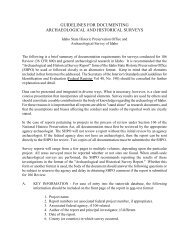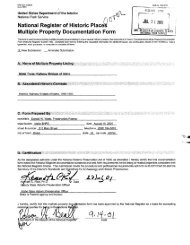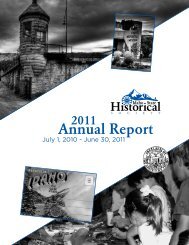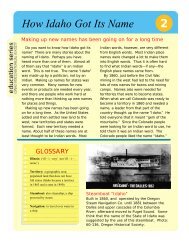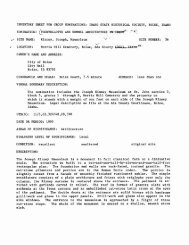Inmates of the Idaho Penitentiary 1864-1947 - Idaho State Historical ...
Inmates of the Idaho Penitentiary 1864-1947 - Idaho State Historical ...
Inmates of the Idaho Penitentiary 1864-1947 - Idaho State Historical ...
- No tags were found...
Create successful ePaper yourself
Turn your PDF publications into a flip-book with our unique Google optimized e-Paper software.
INTRODUCTIONA HISTORIC MYSTERY, SOLVEDby Rachelle N LittauResearching history is like detective work. You scour<strong>the</strong> scene, look under every rock, talk to every possiblewitness, review security tapes (okay, historic photos)and from your findings try to present <strong>the</strong> most accuratepicture <strong>of</strong> an event as you can. Of course, <strong>the</strong> findings aresubject to <strong>the</strong> detective’s interpretation. The Old <strong>Idaho</strong><strong>Penitentiary</strong> can be a particularly difficult and sometimesfrustrating case to crack.The Old <strong>Idaho</strong> <strong>Penitentiary</strong> at Boise served as <strong>Idaho</strong>’sprison for 101 years. Following <strong>the</strong> <strong>Idaho</strong> Department<strong>of</strong> Correction’s move to a new institution south <strong>of</strong>Boise in 1973, <strong>the</strong> <strong>Idaho</strong> <strong>State</strong> <strong>Historical</strong> Society tookover administration <strong>of</strong> <strong>the</strong> site. The acquisition <strong>of</strong> <strong>the</strong>prison site and its subsequent opening to visitors gavepeople from around <strong>the</strong> world <strong>the</strong> opportunity to enter<strong>the</strong> cellblocks and walk <strong>the</strong> yards where prisonersworked and lived for more than a century. While simplywandering through <strong>the</strong> site is a powerful experience, thatexperience becomes more meaningful through sharingstories <strong>of</strong> <strong>the</strong>se prisoners. This is where <strong>the</strong> detectivework comes into play.Beyond <strong>the</strong> physical prison site, <strong>the</strong> <strong>Idaho</strong> <strong>State</strong><strong>Historical</strong> Society administers a vast amount <strong>of</strong> resourcesthat contribute to <strong>the</strong> interpretation <strong>of</strong> this historicinstitution. The <strong>Idaho</strong> <strong>State</strong> <strong>Historical</strong> Museum holdspersonal artifacts used by guards and inmates, while<strong>the</strong> Society’s Public Archives and Research Libraryholds a vast collection <strong>of</strong> research materials includingphotographs, oral histories, wardens’ reports, and inmatefiles. Yet even with all <strong>the</strong>se resources <strong>the</strong> Old <strong>Idaho</strong><strong>Penitentiary</strong> still contains mysteries that require detectivework to try to solve.The case <strong>of</strong> Douglas Van Vlack (no. 5264) is an excellentexample <strong>of</strong> just one <strong>of</strong> those mysteries. Van Vlack received<strong>the</strong> death penalty for <strong>the</strong> kidnapping and murder <strong>of</strong> hisestranged wife. He was sentenced to hang at <strong>the</strong> prisonon 10 December 1937. He never made it to <strong>the</strong> gallows.After visiting with his mo<strong>the</strong>r on 9 December, Van Vlackslipped past guards at <strong>the</strong> prison and climbed into <strong>the</strong>rafters <strong>of</strong> his cellhouse. After a short time in <strong>the</strong> rafters,Van Vlack proclaimed, “My mo<strong>the</strong>r told me it was allright for me to choose <strong>the</strong> way I wanted to die. I’ll neverhang on that rope.” He <strong>the</strong>n dove head first into <strong>the</strong>cellhouse’s concrete floor. He died from his injuries afew hours later.The story sounds straightforward but one small bit <strong>of</strong><strong>the</strong> tale is difficult to determine. Which Old <strong>Idaho</strong><strong>Penitentiary</strong> cellhouse was <strong>the</strong> location <strong>of</strong> Van Vlack’ssuicide? There are two possibilities. Today, <strong>the</strong>se twobuildings are called <strong>the</strong> “New” Cellhouse and “TwoHouse.” Inconsistencies in <strong>the</strong> existing evidence add to<strong>the</strong> confusion. However, an educated guess can be madeby examining and interpreting all <strong>the</strong> available evidence.The <strong>Idaho</strong> <strong>State</strong>sman, a Boise newspaper, provided a greatdeal <strong>of</strong> evidence for this story in articles published in <strong>the</strong>days leading up to Van Vlack’s impending execution andfollowing his subsequent suicide. These events were frontpage news in <strong>the</strong> 8, 9, and 10 December 1937 editions.Most <strong>of</strong> <strong>the</strong> evidence from <strong>the</strong> <strong>State</strong>sman indicates thatTwo House was <strong>the</strong> site <strong>of</strong> <strong>the</strong> suicide. Photographs inboth <strong>the</strong> 8 and 9 December editions show <strong>the</strong> exterior<strong>of</strong> Two House and identify it as <strong>the</strong> building where VanVlack awaited his fate. The 10 December edition printedan interior photograph <strong>of</strong> Two House as well as an “X”drawn where Van Vlack purportedly climbed onto a tableto gain access to <strong>the</strong> second floor to begin his upwardascent. No table is shown in <strong>the</strong> photograph.Three articles about Van Vlack and <strong>the</strong> event appearedin <strong>the</strong> 10 December edition <strong>of</strong> <strong>the</strong> <strong>State</strong>sman. One <strong>of</strong><strong>the</strong>se articles stated that Van Vlack “…hurtled from asteel rafter 28 feet above <strong>the</strong> concrete floor in <strong>the</strong> deathhouse.” Again <strong>the</strong> evidence points directly to Two House.It has steel rafters as opposed to <strong>the</strong> wooden rafters in <strong>the</strong>“New” Cellhouse.There are, however, a few instances in <strong>the</strong> 10 December<strong>State</strong>sman that throw doubt on <strong>the</strong> assumption that TwoHouse is <strong>the</strong> location <strong>of</strong> <strong>the</strong> suicide. The 10 December “Condemned Prisoner Suicides In Wild Leap To Corridor Floor AfterEluding Prison Guards,” <strong>Idaho</strong> <strong>State</strong>sman (10 December 1937), p2, c4 The “New” Cellhouse, <strong>the</strong> first cellhouse built after <strong>the</strong> original structurein 1870, was constructed in 1889. Construction on Two House, alsoknown as <strong>the</strong> North Wing, began in 1899 and was completed in 1911. <strong>Idaho</strong> <strong>State</strong>sman (8 December 1937); <strong>Idaho</strong> <strong>State</strong>sman (9 December1937); <strong>Idaho</strong> <strong>State</strong>sman (10 December 1937)




